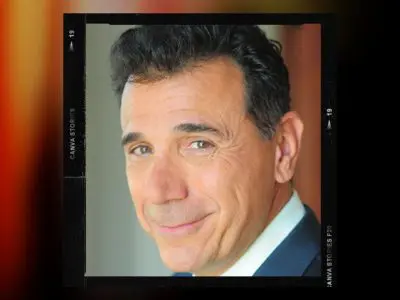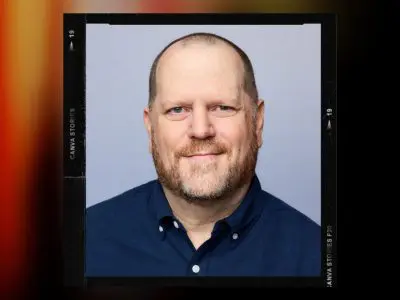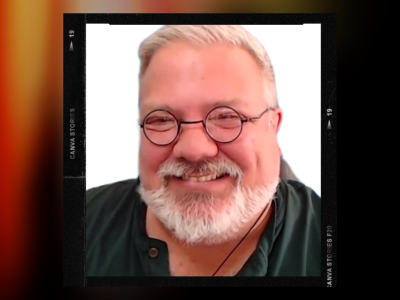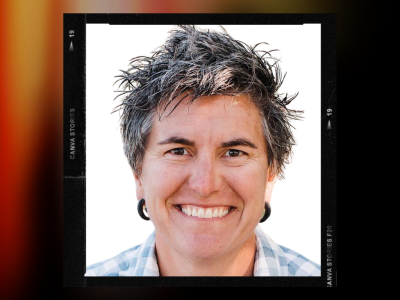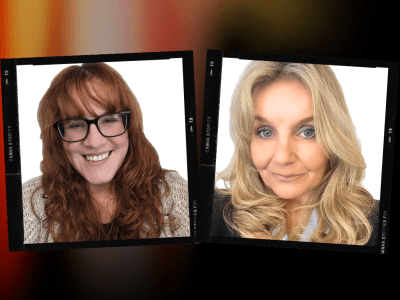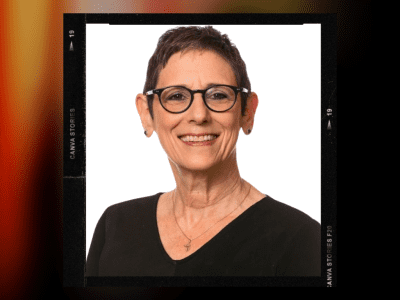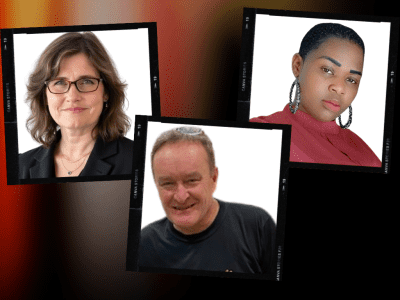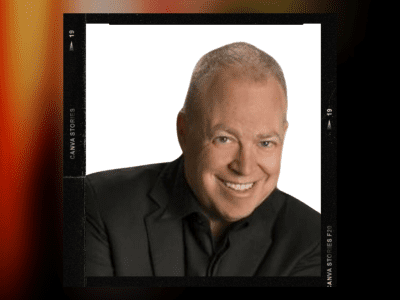Scenario Planning: From “What If” to “What’s Next”
w/ Jeremy Nulik
Use the buttons above to listen now.
Transcript - Scenario Planning: From “What If” to “What’s Next”
Rich, Host: Hello, team. It’s me, your old friend, Rich Rininsland, host of Team Building Saves the World. The show where I speak to thought leaders from around the world discussing variable strategies and tools to help you and your team build a better work environment.And today, we’re heading into the future. Talking to futurist, journalist, and executive coach, Big White Sky’s Jeremy Nulik.
But first, I have to share some love with all my supporters at TeamBonding. If your team is ready to experience teamwork for the power of play, then visit TeamBonding.com to learn more. Now, teams, join me in welcoming my guest, a futurist whose website opened by telling us that he was, quote, Born cold, wet, and naked, Jeremy Nulik.
Jeremy!
Jeremy Nulik, Guest: Good morning.
Rich, Host: Good morning, thank you so much for coming, how are you?
Jeremy Nulik, Guest: Where am I? Yeah. I’m, I’m in St. Louis, Missouri. We are experiencing the all of the seasons at once, as is usually the case. This morning it was like 40 degrees, by this afternoon it’ll be 90. So that’s how we roll.
Rich, Host: Yeah. That’s very New England weather, which is where I come from as well.
Jeremy Nulik, Guest: There you go. There you go.
Rich, Host: Got to experience all the seasons. So let’s start off. I, I always generally like to talk to people and open the same way because my team out there really wants to know about who you are. So let’s just give them a brief intro, if you can tell them a little bit about who you are. I understand you started out in journalism, but now you’re doing this. So how do you get from that to this?
Jeremy Nulik, Guest: Well, oddly, I think I’ve just always been someone who is fascinated with some kind of an underlying story or something that lies beneath what might be obvious, you know, so that sort of curiosity actually in college, I was studying to pursue science for that reason. I thought science would be the place where you’re like, well, chemically what’s happening or biologically what’s happening. You know, that would explain sort of the realities that we run into. And fortunately, or unfortunately for the people who are footing the bill for my tuition, I started working in a writing center and started pursuing language and started seeing that the way that we narrativize stories actually has a lot to do with the kind of reality we construct.And sometimes science has less to do with what we actually experience. Sometimes you know, how do we make sense of the world was what was curious to me when I started to work in a writing center. These women would bring in like old ladies would bring in their memoirs, right.
Or poetry students would bring in their bad poetry, right? And so, you would and reading the words back to someone about what’s how it meant to them. Like what this, what this work meant to them, you know, you started to see that this is how they make sense of the world. And so that was what led me to pursue journalism because I thought, well, that is as part of, you know, journalism communications.
How is it that people construct meaning. How do they come up with something that is meaningful? And so that actually led me to a series of you know, the work that I did both on the journalism side and in PR, because if you’re good at the one typically you can also get, let’s just be honest, paid better to hype up a brand or people or what have you. And so you, you figure out how to position people. Well you learn about brand, you learn about what that means. And there, there are some elements of, you know, that same kind of question. What is the meaning behind something? What’s the narrative that holds it together?
Brands do that. So I did that work for a while and I had a story, a concept that I was sent out on on an assignment to cover a CEO and I went to go cover that CEO at an event, and the the interview just went awful. It was just a terrible interview. Nothing, everything that was said to me was some kind of bromide, you know, like it was just a, you know you know, sort of like, well, fail fast, you know, like these little sound bites and stuff.
And I was just like, gosh. Darn it. And the whole time I was doing this there was another guy who approached me right afterwards who had been watching the interaction that I’d had and said, that was a really awkward interview. He then told me about all of the failures he’d had in a, In a literal sense as a business owner, and he was so candid and he was so sort of brave about this.
And I said, do you mind if I put words to this? And we publish a story. So I did. And that person was Elliot Frick, and he was the founder of Big Wide Sky. And around that time, I had developed my own curiosities about you know, what is next for me? And when I started to see that what they were doing with Big Wide Sky was they were marrying sort of this concept of storytelling, communications, what have you.
I do describe a lot of us at Big Wide Sky as recovered communications people for this reason. You know, like we’re the kinds of people that are used to like, somebody came up with an idea and then they hand it over to me. So people who are supposed to put the words and images together to do this, make it look pretty.
And some of the curiosity we had was, well, what if you took those people and you apply them to the central strategic challenge, you know, instead of waiting to bring in creative people till after you had already figured out everything you thought you needed to figure out what if the creative people were at the center of the challenge, you know, and foresight strategic foresight, was a, is a, methodology that we use to do that, you know, so it creates this canvas for executives to begin to question in a methodical rigorous sort of manner. Like, well, what might be what kinds of futures am I more attenuated toward? What kinds of futures did I not even know I might want?
And how do we have conversations about that in such a way that we solve something meaningful, deeply and fundamentally meaningful for an organization? So that’s kind of the trajectory, but from telling stories to meeting an odd person to then going and working alongside him at his company.
Rich, Host: Is that how you would define being a futurist though? Like what is your definition?
Jeremy Nulik, Guest: Oh very good. Yeah. I mean, so, I mean, being a futurist in the context first of all, there’s a number of people who. Use that moniker and so but I think that, you know, for, for my purpose, what it means is I, I work alongside people who want to get to know the future you want to get to know it.
Leaders you know, there is this sort of common phrase that has said that, like, if you want to be able to predict the future, then build it. Right? I think there is some truth in that, you know, I think that there’s also some hubris. Right? Like do you think that you have the leverage to actually control a singular kind of future that everyone experiences?
And so what we do as futurists is we help to say, well, there’s a plurality to the future. There’s a, there’s a sort of topography. There’s a possibility space and your ability to navigate it usefully to come up with like, what are the things we see out there that could either disrupt us, that could be opportunities for us or, what things would need to change and what would need to stay the same and how do we make strategic decisions that design with that in mind? You know, how do we design a solution with that in mind? And I mean, for my part, I think, and what relates, I hope to, you know, your audience the best is that often where this kind of thinking is applied the best is in challenges that have to do with people.
You know, people, people are overwhelmingly just the people issue that exists in business is overwhelmingly cited by nearly every executive we work with as the central challenge in their business. If only the people would just get in line, if they would just behave the way we want them to, right.
Rich, Host: I often say how much I love my, my job. If it weren’t for the people,
Jeremy Nulik, Guest: I mean, I’ve, I’ve thought this myself, of course. I mean, all the way back to one time I was a superintendent at a golf course and I was like, man, working on a golf course, is really fun, it’s just the golfers that are but but yeah, I mean, the, the same is true in corporate world.
Right. I mean, it’s look, we, we build systems and machines and they always behave the way, or at least most of the time behave the way that we’d like them to, but human beings are messy. And they have needs. They have developmental you know, needs. They have circumstances. All of this stuff makes them messy to deal with.
Right. And so one of the things that I hope comes to light when we work with companies is that generally, the best way to give a commander’s intention to set a direction for a business and organization is to give an articulation of vision that allows for some like provision for what might happen.
So how, how good are you at articulating vision? People don’t typically follow a plan, you know. There’s so many great plans that sit and gather dust. But why might that be? Well, because there isn’t a vision that’s actually animating what that plan means. People typically follow a vision. They don’t follow a plan.
So figuring out a way around how to articulate vision is part of the function of futurists from a, an organizational perspective. You know how good are we at articulating where we want to go and why we want to go there?
Rich, Host: But how is it that you can talk to these CEOs, these, these corporate managers and make sure that their future visions still incorporate the people that they have to bring along with them?
Jeremy Nulik, Guest: Sure. I mean, most of the time what you, you try to do is you give people the most provocative sort of set of circumstances and, and part of, and it’s a weird way around your question, I realize, because of what I perceive you’re asking is like, how do they account for the fact that there are people that they need to be mindful of or incorporate into their design of their strategy?
Right? And what’s amazing is when you put people in a situation where there’s a simulated kind of future right at the outset suddenly all those circumstantial sort of people issues. They, they’re just not as apparent. So they start talking about what really matters to them. So an example of this is we, we did this work with an NGO that is in agriculture and we actually provided them immediately a scenario.
We, and we will, like I say, we recovered communications people. So we developed an immersive set of artifacts in the form of a video product line, a product catalog, all around a startup that had started in the present day, but this was a corporate announcement 10 years in the future and it showed them like this is what would really disrupt your business and it would completely take away the fundamental systems that you currently have the way that you work.
And by the way, this isn’t just like, science fiction, it’s based on research that we did and stuff that really exists right now, like this stuff could happen, you know, and so what they were able to do is to start to have conversations about what, are we really after, though, you know, at the end of the day, are we really after sort of championing farmers?
Are we after trying to solve some of the hardest challenges in the world? And so when they start to get to an articulation, like, let’s figure out what kind of challenges we want to solve and what really matters to us. When you take that narrative and you say from an internal brand perspective, this is why you’re valuable and the kind of thing that we really need you for is to solve these kinds of challenges.
We’re not just here to check the box, you know. You can invite people into an adventure. You can invite people into, you know, some kind of vision. And honestly, sometimes it has just the same effect of, well, I don’t want to be a part of that vision. Well, perfect. You know, that’s good to know. Now, you know, because we want to find people who want to do the things that we’re trying to achieve.
That’s that’s, you know yeah. If there’s going to be a basis on which somebody says that they no longer want to be a part of an organization, then what better basis?
Rich, Host: So, it sounds to me from the layman side that I’m coming from in all this, you’re basically just talking about the ability to perceive, just the foresight of what you’re going to be growing into.
Would that be correct?
Jeremy Nulik, Guest: Yeah, it’s it’s some acknowledgments. Yeah, that like right now today even Rich, you have images of the future in your mind that are alive. And the degree to which you can bring them into any kind of resolution that you can articulate then you can begin to shape the trajectory of your professional career, of your, you know, of your business, of what have you, right? So that’s, that’s sort of the magic.
Rich, Host: There are many people who would, who would argue with you that I have any kind of future vision for my career.
Jeremy Nulik, Guest: Of course you do, of course you do. It’s all genuine. I mean, I get it. Yeah. People would make the same arguments about me.
Rich, Host: What are we talking about though? What are some of these future artifacts that you had, had been talking about and, and how do they actually serve as the tools that organizations need,
Jeremy Nulik, Guest: Right. So, I mean, the, the future artifacts, I mean, and that is, but one sort of, there is a a formalized method to foresight. Of course, every discipline has its method. But one thing that I think for people who are just interpreting, like what might foresight mean or what could it do? One of the you know, the sort of the section of foresight that if you might, is called design futures or speculative design. And that is usually a discipline around the use of artifacts from the future, and their role in helping us to have conversations that are provocative and then in their nature.
So if you think about artifacts from your past, right. I know for me, I’ve, I’ve got a shoe box. That’s got you know, photographs in it. And I could tell you a story about nearly every photograph in there.
And none of those photos are things that I actually like the, some of them are me when I was an infant. You know and so there’s no way for me to know that that’s actually reality. It was provided for me, right? But the moment I look at those photos, I’m lifted out of my present day and I suddenly begin to think about the things that matter to me.
Like there’s a picture of me and my dad. You know, my father was a high school teacher and he was just working, you know jobs on the weekends, you know, grew up in rural Kansas. So he’s got, work he’s trying to do to support his family. And I can see that, I mean, he was a young man, he was like 25 or something like this, and he’s just trying to build a life.
So all of this stuff comes to life for me in the present day, I’m still just sitting there looking at a photo, but suddenly all that narrative comes to play and I start to remember the things that matter to me and I start to remember the sort of values that I was taught and the things that transcend my present moment.
In much the same way, if you can provide people an image or a construct from a possible future without giving them really much context, people will begin to create a narrative. And they will begin that narrative with the things that really matter to them deeply that transcend time. And that’s the function.
So an example is There’s an organization that helps people. It’s a, it’s a very large company and based in St. Louis and they help people with rental vehicles, right? And they were shifting the focus of what they were, what they were after from a narrative or brand perspective from the function of being known for renting vehicles to the concept of mobility in general, right?
So that’s a different, that’s a higher level concept, a more abstract one, right? Like here are cars, there’s cars on the lot too. We help people with mobility generally. And so what we began to inquire with them is like, well, what, what kinds of internal and what they’re, they’re contending with at the time was an internal challenge around like, how do we make that make sense to people in their day to day lives?
Like the people who work in this organization, if you shift this brand to something that means something else, what does it mean to everybody? Like, how do I sit around and do mobility, right? Yeah. What does that mean? Right? And so to give it something that first of all is the benefit of artifacts is that they’re tangible, right?
So it’s something I have to interpret. The second thing that’s really beautiful is that they’re usually, to be honest, they have to be just ridiculous enough that they force you to be provoked or depart from your present day circumstance. There is a famous futurist named James Dator, and I’m going to botch the exact articulation of the quote, but his second law of futures is something like, any useful vision of the future will seem ridiculous, right?
And so the point of that is that usually the kinds of realities we find ourselves in and within 10 to 20 years, if you were to go in a time machine and go back in time to talk to yourself, then you would sound ridiculous, right? Like, let’s just look at the presidential candidates and you had to go back to rich 10 years ago and say, these are the two people we have right now.
And so it would seem silly. But it’s reality, right? And so one of the examples of one of these artifacts is Yeah. We created something we called the “Desk Doge.” And it is a a desk that you would, you would sit at and it actually is covered in fur and it pants and it has biological needs and you can walk it around, right, so that you also, your, your your sort of steps in for the day, what have you and it is something that helps to elevate the experience ostensibly of employees who choose the desk doge option because it helps them to care for another thing. It helps them to care for a dependent and it, it has all of those wellness sort of you know, manifestations that you get from allowing pets in an office, but with all of the hypoallergenic qualities of you know, not upsetting your coworkers with your dog, right?
So, well, what was that based on? Cause that sounds silly. Well, there was actually some research that had come out that said that that people, they, they were pet owners surveyed who also had children and they had they had a greater positive sentiment for their pets than they did their own children.
So first of all then there were there’s just so much research that’s done on, you know, the, the benefits of a focus on corporate wellness and its impact on people’s professional development. So their mobility, right? So mobility started to mean more than just helping their customers move. It meant helping people in their professional mobility, helping people in their developmental mobility.
How can we stimulate that as a culture? And so the deliverable on this, which we still have yet to fully realize, to be honest, is that they’re moving to a new, this, this group is moving to a new office and we hope to have these actually 3D objects in that office. In such a way that they can begin to tell the story about what mobility means like this is how serious we are and how ridiculous we’re willing to be in driving forward the concept of what our investment in your mobility means.
So it’s better. It’s different than like, we’re not just going to hang a poster and say, like, you know, we care about you sort of stuff. We’re actually going to invest in exploring what’s possible.
Rich, Host: Nice, and I want to explore more about this in just a second, Jeremy, but I hope you don’t mind. I do need to step away for a quick second so I can tell all my team out there about a company, I am so very proud to be a part of, TeamBonding. TeamBonding was founded over 20 years ago with one simple question. How can employees have a great time while fostering strong, authentic bonds between people who work together?
No matter where your company is located, even if it’s in Singapore, TeamBonding offers powerful, engaging, custom team building events, designed to get the best out of your team anywhere in the world. They’ve created a catalog of innovative events using the power of play as a learning tool and tapping into the correlation of work and play.
So whether it’s scavenger hunts to Jeopardy or so many more, the TeamBonding of activities, whether it’s live, virtual, or hybrid, maximizes the impact of team building with an accent on fun. Visit TeamBonding.com to schedule your event now. TeamBonding, when you want seriously fun results. And we are back talking about the future of business and how to get ourselves there with Jeremy Nulik. Jeremy so what you’re talking about is you, when you, as soon as you said the presidential campaign, all I could think about is for some reason back to the future, that moment where Marty and Doc first meet and he says, who’s the president in 1980s?
And Marty says, Ronald Reagan. The actor, the actor, right? So, so how can we bring a company that is, because many people I’m sure are like me where they are, they’ve been told very much throughout most of their lives is from, from early infancy onward that you have to be in the here and now you’re too much, you know, looking to the future as Yoda himself said, if I can quote, get more movies, never everywhere you are, how do we get companies to actually give themselves the freedom to let imagination become a big part of what they do?
Jeremy Nulik, Guest: That’s a really great question. I think that candidly, The recipe that I’ve seen that allows for this most readily is a sort of like forced feeding on humility.
COVID 19 actually helped with this a great deal, right? Who had in their cards that this would be the thing that would disrupt supply chains and health and our wellbeing in general and all kinds of communities of people, right? So there was sort of a forced feeding on it. But I think that the, the, the, the call to bring imagination back into the strategy of a firm or back into how do we really set the course for what we do. First of all, you know, where I would start if I was just, you know whomever is there’s a number of ways, there’s actually a a format that you can follow just for yourself and your own personal futures.
And it it’s a, it’s a visualization that you can begin at any point and you can actually even do this daily, but if you know, Rich, when you woke up, This morning there in Boston and the cell phone lit up on your nightstand what have you, you you know, you, you woke and you made a decision to be on this podcast with me right now, you know, in this moment.
But if, if in this moment instead, what you’d thought was, you know, there’s this place I’ve always wanted to go. And I don’t know where it is for you, but if even you’re visualizing right now, like there’s this place that I’ve been wanting to go and I just been putting it off and there’s always a good reason and there’s always an obligation on why I don’t go but I’d really want to go there.
Right. And so if you start to think about like, well, what would be involved, right? So if you. Decided, actually, let’s go back in time to this morning and you, Rich, decided that when your cell phone started to glow, you decided, you know, I know I have obligations, but this is just more important to me for whatever reason.
And so I’m now going to begin the process of packing my bag. I’m going to start figuring out who I need to talk to to let them know I’m spending the night. skirting out on my obligations, Ferris Bueller style, what have you, and I’m going to just go to this place, right? And if you were to start that process, let’s assume you were and it’s what, it’s 9:30 where you are.
So if you were to have made that decision this morning, where would you be right now?
Rich, Host: Well, if
Jeremy Nulik, Guest: If you had a plane or no..
Rich, Host: I’d be in my car.
Jeremy Nulik, Guest: Okay.
Rich, Host: I’d be in my, cause wherever I’m going, I’m taking my dog with me.
Jeremy Nulik, Guest: Okay, great. So you’d be in your car and your dog’s in your car with you. What’s what’s playing on the radio?
Rich, Host: Probably probably like a DND podcast, listening to play games as I’m driving one of my favorite things.
Jeremy Nulik, Guest: Right, right. And so like that kind of there, there is a version of, of Rich right now in some simulated world that is riding down the highway with his dog, listening to a DND podcast.
And that person, he’s fully engaged in doing that. He knows, you know, why he’s doing it, all of it. Right. But for whatever reason you did decide and thankfully for me to be, to be on this podcast with us, of course. But what I think, you know, even a simple sort of thought experiment like that can do for you.
If you were to say, well, what if this morning I just made a different decision about where I want to be today. And then you go through the process of visualizing what would be involved in doing it. And then you start thinking about, well, where would I be in this moment? Where is that alternate version of me right now?
What it exposes is the agency and the contingency of your future. Like, a lot of times, the reason that imagination, I think, is critical for bringing about the change we seek is that we usually leave the responsibility for our current circumstances up to other people. And what really is the truth, though, is that you’ve made decisions.
You know, if there’s anyone who’s responsible for your station in life or what’s going on with your business or what’s going on with your company, it’s you. And so you can expose that agency. And there’s one way to do it, that’s intellectual, like I just did, which is to say it right. It’s another thing to immerse yourself in a different kind of reality.
Like what kind of anxieties does that version of rich have? Cause he didn’t escape them, right? There’s other things he’s worried about. There’s other things that would be a cost to doing that, that you’d have to deal with. Right. The point is like, are those the kinds of anxieties you prefer to deal with?
Are those the kinds of challenges that you like to deal with? So it can start even with just a personal reflection of, of that sort of thing. Now, when it comes to like executives, like I said, most of the time it’s usually when how do we begin to think about the utility of imagination at an executive level for an organization to make decisions about them.
The, the first way is usually through some kind of like, something’s not working anymore. Everything that we thought would happen isn’t happening. And so we’re going to have to examine what alternative kinds of understanding there could be.
Rich, Host: Well, that’s exactly where I was going to go next talking about being a futurist. As if I were a corporate leader at an organization or even high enough up in management for people to listen, what kind of warning signs do I need to look for when I, I know that I should be contacting someone like you.
Jeremy Nulik, Guest: It’s really interesting. I, you know, most of the time it has to do with people. I mean, that’s probably the lead reason why is when there is a lack of alignment, engagement, zeal, whatever, you know that that used to be there, or you have a sense that it was, and then it suddenly is gone and you don’t know why. And it’s difficult to suss out and explain. And part of the reason why is that, like I said, you know, human beings are not automatons.
So they don’t just react to stimulus the way that a machine does. So it’s because there’s a mechanized, you know, sort of challenge. Sometimes the other reason though, is that look, I just know, I know there’s a vision I have. Like if I’m that executive, who’s looking at, do I need it? Do I need somebody who has any foresight understanding in this?
I know there’s a direction I really want to go. And it’s not this. You know, I know that there’s a strategy I want to put in place and it, it’s, it’s something’s missing. We do usually get called in when there’s a transition. So like it’s a family business and it’s the next generation or it’s, Someone who was a more autocratic, you know, sort of leader, and then they anointed their next in line for, you know, however, that succession would work, or it’s there was like an executive search done and they pull somebody in to be the CEO.
But those people usually have like, I know there’s a direction I want to go, and I know that I’ve been trying to say it and nobody’s biting. Like nobody gets as excited about the vision that I have. And sometimes it isn’t that it’s not a great vision. It’s that there isn’t an accounting or a possibility inside of it.
So it feels flat to the people you’re trying to enfranchise into your vision. And so those are usually most of the circumstances that surround, like, why would I even? Think about talking to somebody with a title like futurist.
Rich, Host: So help me help them realize that you’re something that they need that, that engaging their imagination is something you can help them to do and, and, and take along the company with them.
I don’t want you to get away the store, but give me a sample of some of the things you might do to help someone in that particular case.
Jeremy Nulik, Guest: Sure. So, I mean, one of the we worked with an architecture firm recently, and one of the situations they were in was that they had moved from they had a founder leader and he created a management structure to leave behind in succession.
And there was just this sort of like. If we’re going to step into this and be who we want to be you know, it just feels like there’s this degree of like, we’re stewarding an, a vision that wasn’t really ours, you know, like, where is our part in shaping this? And so what we did was we took them through a series of foresight activations.
We did research on their market. We did some landscape analysis of, you know, what is emergent in their, in their market what kind of signals of the future exist because of, of where they are and where they’re situated we were able to start. Certainly there’s just an analytical sort of report side to this.
So the first thing that usually happens with that group is that they’re able to at least look and say, wow, there’s actually more. Out there than we realized, you know, there’s just this sort of moment of there’s actually more possibility than maybe we thought. And then when we lead them through a series of activations, where we actually from a DND you’ll appreciate this, you know, when you, we put them into situations where look, you are CEO of this group, here is the circumstance 10 years in the future from now that you’re dealing with. Tell me here are arcs of the future and you need to help us to understand what went really well because of that future. What kind of stories can we tell about that? What failed and what collapsed because of the decisions you made? What did you put in place to keep things from going into collapse, right? And then also what is potentially transformative about the kind of future you’re creating?
When you give people circumstance-based sort of things like this, right? What they came to was an understanding at the end of it, probably where in the gestalt, right? Like if you map everything on top of each other and you look at it, they were able to say, you know, what we’re really after is like architecture.
While it is a design pursuit and art and something they care about is really incidental, the thing that they really cared about was serving the most deeply fundamental human needs of communities. Like they were, they realized, and they were able to coalesce around an understanding that, that this art that they create was intended to serve and serve people who they don’t even know.
Right? Because if you if you manipulate the built environment, it’s around for 50 to 100 years or something like this, right? And so it’s like, well, how do we begin to build empathy for people will never meet? Like, those are the kinds of and that has some vitality to it. You know, it’s got life to it.
And so then when you start to make decisions, then based on well strategy starts to get involved because it’s like, well, we have things that we need to make decisions on before the end of the year. We have things that we need to make decisions on next year. We have goals. We have KPIs we need to meet, right? So how does this help us with any of that? Well, what it helps to do is it creates strategic coherence, like because there’s, there’s so many people who have ideas, right? Facilities thinks that you need to build a new whatever, you know, like something and marketing thinks you need a new brand.
And they have data reasons to back up why it is they want to make them. But the real issue, the challenge with all of these various sort of groups of people who all have really good data based ideas is what is the strategic coherence that animates why we would fund one thing over another or why we would put our resources in this area or another.
And the best reason why is because you’d want to be able to say, well, investing in this gives us a greatest possibility of achieving the kinds of futures we want to achieve. So the things we want to make more possible are better invested if we move this direction, you know, so not to give away the store too much also, or, or sound like such a sales pitch, but I mean, that’s, I mean, that’s the, the deal, right? Is it’s like, what, what is the coherence? What, what, what girds it, you know, what brings it together?
Rich, Host: Well, speaking of which if, I mean, cause it’s been a fantastic conversation and I can go on and on and on.
Jeremy Nulik, Guest: Terrible interview.
Rich, Host: I apologize. No, you’re doing great,
Jeremy Nulik, Guest: I’m the most soundbitey person in the world.
Rich, Host: But actually the thing that I’m, I, I really, because I know there are going to be people out there who if I don’t ask this are going to be yelling at me as to why I did. What does the future look like? Especially for corporate America and the market.
Jeremy Nulik, Guest: Well, I mean, I think that there will, well, first of all, I think we are at a deep inflection point in what we understand the role of business to be and I, I think that there’s there’s something archetypal about it. And so it’s, it’s almost like well, again, you’re a DND person, right? So like, if there’s some, there’s, so there’s an archetypal quality to where we’re at, as in the concept of business, and that has to do with like a shape shifter sort of archetype, which means, you know, is business intended to serve business? Is business intended to serve the the human beings and communities that it ostensibly wants to serve? And so I think that if anything, COVID 19 helped us to see that we’re at that inflection point.
You know, how might we make the decisions we need to make? So to me, the future of business, it is my., if, if I have any influence or leverage at all, it’s intended, like some of the work we do and some of why it is, I want to do the work as a futurist that I do, is I’d like to make more possible the kinds of futures that that help us to see that business serves a human need.
That helps us to see that business was intended to do that from the, in the first place.
Rich, Host: Yeah.
Jeremy Nulik, Guest: And not to try to also weasel out of your question, but like, well, what’s the future of business? Well, it’s what you make it, man. You know, like, I mean, some of it’s like you, you have agency in shaping the kinds of things you want.
So if you don’t like it, there’s look for your leverage points, look for the places where you can have influence, look for the places where you can tell stories about the kinds of futures you want to see and find the people who care about them the way that you do and do the work to be the the sort of disagreeable or potentially even crazy or ridiculous imaginative person that if, if that’s the level of transformation you seek, then be that, right.
So, you know I hate to always do that, but I mean, yeah. What’s the future. Well, it’s what, what you want to make.
Rich, Host: I think we said it, you say it all right there. I love it. Jeremy Nulik, my friends out there, please team, give him a big round of applause. Thank you so much, Jeremy. Thank you for coming on, man. This was a great talk. Thank you. I hope you had a good time.
Jeremy Nulik, Guest: Oh, I had a great time
Rich, Host: Well, I hope you feel that way because it is time for my speed round.
Jeremy Nulik, Guest: Oh, that’s right.
Rich, Host: So, just to remind you what we talked about before the show this section is just about 60 seconds long. I’m going to play some music in the background and just helps me keep it tracked, you know, where we are and how much time I have left during that 60 seconds, though, here’s the meat and potatoes of it.
I’m going to actually ask you a bunch of completely innocuous questions. It’s just. Silly little, you know, short phrase answers, whatever you want to make of it. The objective is as a game is try to see how many you can get answered within 60 seconds. As I told you before, I don’t know how, how, you know, Competitive you are, but the number to beat is a massive 15 questions answered in 60 seconds.
You think you can do it? Let’s give it a go, man. I think so. All right, my friend. Fantastic. We’re going to hear some music. I’ll ask the first question and here we go. Let’s have some fun.
Rich, Host: What’s your name?
Jeremy Nulik, Guest: Jeremy.
Rich, Host: How many kids do you have?
Jeremy Nulik, Guest: Five.
Rich, Host: Which one’s your favorite?
Jeremy Nulik, Guest: All of them.
Rich, Host: You have any pets?
Jeremy Nulik, Guest: Yes.
Rich, Host: If you could ask your pet a question and get an answer, what would it be?
Jeremy Nulik, Guest: Why do you have to just run all the damn time, ?
Rich, Host: If you could time travel, where would you wanna go?
Jeremy Nulik, Guest: Probably to like the, the late to mid sort of century.
Rich, Host: Okay, favorite TV home you would love to live in?
Jeremy Nulik, Guest: The Jetsons.
Rich, Host: Nice favorite ice cream flavors.
Jeremy Nulik, Guest: French Vanilla.
Rich, Host: What is your favorite movie?
Jeremy Nulik, Guest: Space Camp.
Rich, Host: Name your favorite celebrity.
Jeremy Nulik, Guest: Michael Keaton.
Rich, Host: Most embarrassing childhood memory.
Jeremy Nulik, Guest: There’s so many to choose from.
Rich, Host: I will take that as an answer. You got 12, buddy.
Jeremy Nulik, Guest:I didn’t. There was some, there was some bad answers in there. Like I was trying to struggle with the England thing. It was, it was, there’s a, like right around like the fifties, you know, in England was when I was thinking.
Rich, Host: Okay. Okay.
Jeremy Nulik, Guest: Screwed up that answer.
Rich, Host: No, that’s okay. Not a problem. And I love the clarification. Excellent job, Jeremy. Thank you so much for coming on, man. I really did. I was fascinated by all of this. If there is anybody out there on my team who wants to learn more about you and about your company, please feel free to let us know now, where can we get ahold of you?
Jeremy Nulik, Guest: Bigwidesky.com. Yeah. B I G W I D E S K Y. com. Unlike the there is, there was a takeout place that was next to us. And when you’d order lunch, you know, it would put the name of the organization on the lunch. And we were known by that takeout places, big white guy. That is not the name of our business, it’s big white sky. So it’s B I G W I D E S K Y. com. I’m Jeremy at that address. So Jeremy@bigwidesky. com. Easy to find us. We’re always interested in any opportunity to just have meaningful conversations with people about how they want to shape their future.
Rich, Host: Great. And hopefully in the future, we can sit down and talk like this again.
I would love that. I would dig it. Rich. But as for you, my friends out there, that’s it. We’re wrapping up yet another episode of team building saves the world. If you’ve enjoyed this episode, whether you’re new to the podcast or an old fan of the show, please be sure to share it with everyone. You know, whether they’re a coworker or a random family member, it just helps us to share all this vital information.
You can find out all about us, including all past episodes of TeamBonding.com/Podcast.You can also find us wherever you find your favorite podcasts, Google Podcasts, Apple Podcasts, Spotify, wherever you go to listen, I promise you, we are going to be there. Don’t forget to look for all of us on the social medias at TeamBonding Podcasts and leave us a message.
Tell me whether you liked the show, didn’t like the show, have an idea for a future topic on the podcast. I want to hear from you. But my friends, before we say our final farewell for this episode of Team Building Saves the World, please never forget you are within the sound of my voice right now. You’re on my team and I am forever going to be on yours.
So long team. See you next time.
September 16, 2024
In this episode of Team Building Saves the World, host Rich sits down with futurist and foresight expert Jeremy Nulik of Bigwidesky to discuss how leaders can craft the future of their business. Jeremy explains how to use scenario planning and strategic foresight to future-proof your business, prepare employees for inevitable challenges, and incorporate imagination and creativity into operational processes. He also runs through his scenario planning process when helping companies work through possible challenges to build resiliency and get closer to reaching their goals.
About Jeremy Nulik:
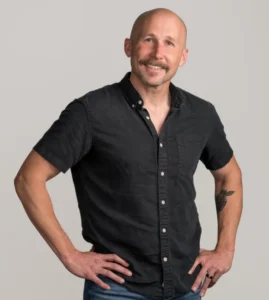
" If you can provide people an image or a construct from a possible future without giving them really much context, people will begin to create a narrative. And they will begin that narrative with the things that really matter to them deeply that transcend time."- Jeremy Nulik
Get more human resources and leadership advice.
Less drama? Greater teamwork and job satisfaction? TeamBonding is here to help you build a stronger and happier team. Subscribe to get our team building podcast and thought leadership blogs sent straight to your inbox.





